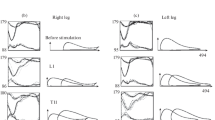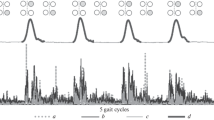Abstract
The possibility of initiating an involuntary walking rhythm in a suspended human leg by electrical stimulation was studied. The subjects lay on the side with one leg suspended in an exoskeleton allowing horizontal rotation in three joints: the hip, knee, and ankle ones. To evoke involuntary walking of the suspended leg, two methods were used: continuous vibration of the quadriceps muscle of the hip and electrical stimulation of the cutaneous nerves innervating the foot of the immobile leg. The hip and ankle were involved in the involuntary movements, with reciprocal bursts of electromyographic activity being also observed in the antagonistic muscles of the hip. The application of an external load (4 N or 8 N) to the foot caused a perceptible intensification of its movements. An additional weight (0.5 kg) or a rubber band wrapped around the foot caused no substantial change in the pattern of stimulated walking. Electrical stimulation is an effective means of activating walking movements, and their characteristics confirm the assumption that the walking rhythm is of central origin. Additional afferentation from the sole’s receptors plays an important role in the modulation of the induced movements and the modification of the general walking pattern under the conditions of muscle unloading.
Similar content being viewed by others
References
Gurfinkel, V.S., Levik, Yu.S., Kazennikov, O.V., and Selionov, V.A., Is There a Locomotor Generator in Man?, Fiziol. Chel., 1998, vol. 24, no. 3, p. 42 [Human Physiol. (Engl. Transl.), vol. 24, no. 3, p. 294].
Gurfinkel, V.S., Levik, Yu.S., Kazennikov, O.V., and Selionov, V.A., Locomotor-Like Movements Evoked by Leg Muscle Vibration in Humans, Eur. J. Neurosci., 1998, vol. 10, p. 1608.
Grillner, S., Neurobiological Bases of Rhythmic Motor Acts in Vertebrates, Science, 1985, vol. 228, p. 143.
Andersson, O. and Grillner, S., Peripheral Control of the Cat’s Step Cycle: I. Phase Dependent Effects of Ramp-Movements of the Hip During “Fictive Locomotion,” Acta Physiol. Scand, 1981, vol. 113, p. 89.
Dietz, V., Role of Peripheral Afferents and Spinal Reflexes in Normal and Impaired Human Locomotion, Rev. Neurol. (Paris), 1987, vol. 143, p. 241.
Rossignol, S., Dubuc, R., and Gossard, J., Dynamic Sensorimotor Interactions in Locomotion, Physiol. Rev., 2006, vol. 86, p. 89.
Wezel, B., Ottenhoff, F., and Duysens, J., Dynamic Control of Location-Specific Information in Tactile Cutaneous Reflexes from the Foot During Human Walking, J. Neurosci., 1997, vol. 17, no. 10, p. 3804.
Dietz, V. and Duysens, J., Significance of Load Receptor Input During Locomotion: a Review, Gait Posture, 2000, vol. 11, p. 102.
Fallon, J.B., Bent, L.R., McNulty, P.A., and Macefield, V.G., Evidence for Strong Synaptic Coupling between Single Tactile Afferents from the Sole of the Foot and Motoneurons Supplying Leg Muscles, J. Neurophysiol., 2005, vol. 94, p. 3795.
Wezel, B., Ottenhoff, F., and Duysens, J., Reflex Responses To Low-Intensity Stimulation of the Sural, Tibial, and Peroneal Nerves During Human Walking, Soc. Neurosci. Symp., 1994, vol. 20, p. 1582.
Moukhina, A., Shenkman, B., Blottner, D., et al., Effects of Support Stimulation on Human Soleus Fiber Characteristics during Exposure To “Dry” Immersion, J. Gravit. Physiol., 2004, vol. 11, no. 2, p. 137.
Aniss, A.M., Gandevia, S.C., and Burke, D., Reflex Responses in Active Muscles Elicited by Stimulation of Low-Threshold Afferents from the Human Foot, J. Neurophysiol., 1992, vol. 67, p. 1375.
Christensen, L.O., Morita, H., Petersen, N., and Nielsen, J., Evidence Suggesting That a Transcortical Reflex Pathway Contributes to Cutaneous Reflexes in the Tibialis Anterior Muscle During Walking in Man, Exp. Brain Res., 1999, vol. 124, p. 59.
Nielsen, J., Petersen, N., and Fedirchuk, B., Evidence Suggesting a Transcortical Pathway from Cutaneous Foot Afferents To Tibialis Anterior Motoneurones in Man, J. Physiol. (Lond.), 1997, vol. 501, p. 473.
Zehr, E.P., Komiyama, T., and Stein, R.B., Cutaneous Reflexes During Human Gait: Electromyographic and Kinematic Responses to Electrical Stimulation, J. Neurophysiol., 1997, vol. 77, p. 3311.
Wezel, B., Engelen, B., Gabreëls, F., et al., A Fibers Mediate Cutaneous Reflexes During Human Walking, J. Neurophysiol., 2000, vol. 83, no. 5, p. 2980.
Duysens, J., Trippel, M., Horstmann, G.A., and Dietz, V., Gating and Reversal of Reflexes in Ankle Muscles During Human Walking, Exp. Brain Res., 1990, vol. 82, p. 351.
Tax, A., Wezel, B., and Dietz, V., Bipedal Reflex Coordination to Tactile Stimulation of the Sural Nerve During Human Running, J. Neurophysiol., 1995, vol. 73, p. 1947.
Carson, R.G., Riek, S., Mackey, D.C., et al., Excitability Changes in Human Forearm Corticospinal Projections and Spinal Reflex Pathways During Rhythmic Voluntary Movement of the Opposite Limb, J. Physiol., 2004, vol. 560, no. 3, p. 929.
Cernácek, J., Contralateral Motor Irradiation: Cerebral Dominance: Its Changes in Hemiparesis, Arch. Neurol., 1961, vol. 4, p. 165.
Gurfinkel, V.S., Ivanenko, Y.P., Levik, Y.S., et al., The Neural Control of Posture and Locomotion: A Lock with Two Keys, Motor Control, Today and Tomorrow, Sofia: Academic, 1999, p. 113.
Seguin, J.J. and Cooke, J.D., The Effects of Cutaneous Mechanoreceptor Stimulation on the Stretch Reflex, Exp. Brain Res., 1983, vol. 52, p. 152.
Rossignol, S. and Drew, T., Phasic Modulation of Reflexes During Rhythmic Activity, in Wenner-Gren International Symposium Series, Neurobiology of Vertebrate Locomotion, London: Macmillan, 1986, vol. 45, p. 517.
Viala, G. and Buser, P., Activités locomotrices rythmiques stéreótypées chez le lapin sous anesthésie légere: Étude de leurs caractéristiques générales, Exp. Brain Res., 1969, vol. 8, p. 346.
Burke, D., Dickson, H.G., and Skuse, N.F., Task-Dependent Changes in the Responses to Low-Threshold Cutaneous Afferent Volleys in the Human Lower Limb, J. Physiol., 1991, vol. 432, p. 445.
Delwaide, P.J., Crenna, P., and Fleron, M.H., Cutaneous Nerve Stimulation and Motoneuronal Excitability: I. Soleus and Tibialis Anterior Excitability after Ipsilateral and Contralateral Sural Nerve Stimulation, J. Neurol. Neurosurg. Psychiatry, 1981, vol. 44, p. 699.
Chang, Y-H., Huang, H-W.C., Hamerski, C.M., and Kram, R., The Independent Effects of Gravity and Inertia on Running Mechanics, J. Exp. Biol., 2000, vol. 203, p. 229.
Author information
Authors and Affiliations
Additional information
Original Russian Text © V.A. Selionov, I.A. Solopova, Yu.P. Ivanenko, 2009, published in Fiziologiya Cheloveka, 2009, Vol. 35, No. 3, pp. 42–52.
Rights and permissions
About this article
Cite this article
Selionov, V.A., Solopova, I.A. & Ivanenko, Y.P. Activation of walking by electrical stimulation in humans under the conditions of muscle unloading and its variations under the effect of afferent influences. Hum Physiol 35, 295–305 (2009). https://doi.org/10.1134/S0362119709030050
Received:
Published:
Issue Date:
DOI: https://doi.org/10.1134/S0362119709030050




